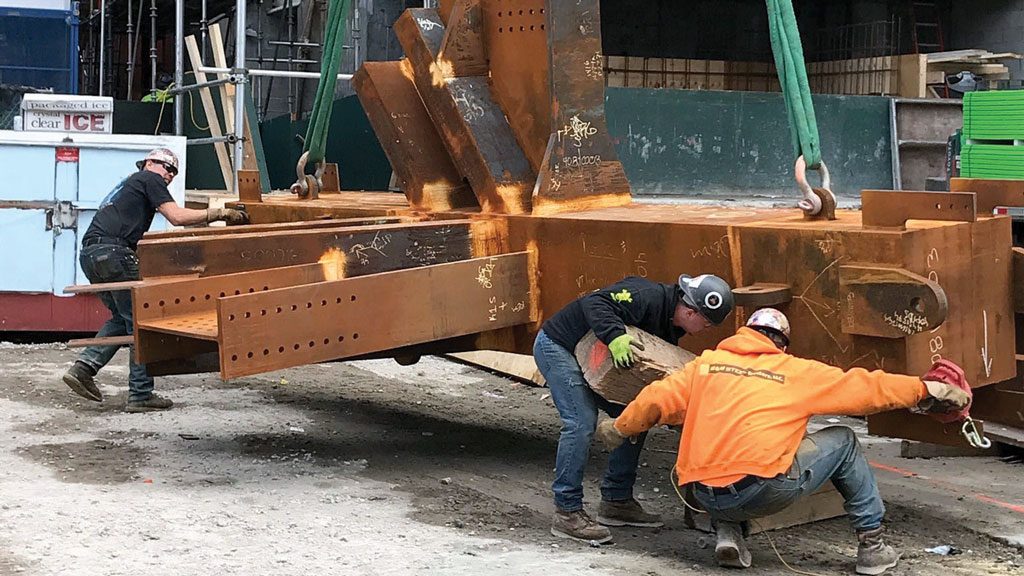As buildings become taller and more complex, developers, designers, and engineers must find solutions to a litany of structural and erection challenges their peers from previous generations never had to deal with.
Toronto-headquartered Cast Connex has developed a technology which makes those challenges a lot less daunting.
Named a finalist for the 2018 Innovation Award by the Council on Tall Buildings and Urban Habitat (CTBUH), the company’s High Integrity Blocks are specially engineered and manufactured solid steel elements which simplify the design and fabrication of heavily loaded structural connections and elements.
Their first application was in the construction of the 386-metre-high (1,268-foot-high) 30 Hudson Yards mixed use development in New York City. Weighing in excess of 14 tons each, the blocks were used at the heaviest loaded outrigger nodes in the tower.
Fracture resistant, weldable, and possessing high mechanical properties, the blocks simplify the design and fabrication of heavily loaded structural steel connections and reduce the need for multiple connections in steel assembly—thus enabling safer and higher strength connections which are less costly to fabricate and more geometrically compact, says Cast Connex co-founder and president Carlos de Oliveira.
Those features improve the overall resilience and economy of high-rise towers and will ultimately allow designers to build taller and safer structures, he says.
And that precisely was the objective of Thornton Tomasetti, the structural designers of 30 Hudson Yards, were aiming for when they reached out to Cast Connex in 2014.
“They came to us looking for solutions,” says de Oliveira, explaining the structural engineering firm was dealing with some significant steel connection challenges.
Not only is Hudson Yards the largest private development in the United States, it spans over the Long Island Railway yard which severely restricts the locations for foundations and support columns—the result of which is very heavily loaded connection nodes.
Complicating the issue were architectural restraints on member sizes which led to the use of heavily utilized solid steel column sections built up from plates stacked and welded together—creating particular challenges at multi-axis connection points, he says.
“Engineering and fabrication of heavily loaded connection nodes in high-rise towers has always been challenging.”
Conventional structural steel is manufactured by continuous casting and hot rolling, a process which results in “poor through-thick” mechanical performance in heavy plate sections.
“Specifically, with increasing plate thickness, the achievable yield strength of the material diminishes and the potential for lamellar defects in the material increases. These material limitations must be taken into account in the design of structural connection nodes.”
Addressing the challenges laid out by Thornton Tomasetti and coming up with a resolution was the catalyst for an intensive two-year research and product development project for Cast Connex and its manufacturing partners.
Initially, creating geometrically complex nodes through steel casting was considered. But that was rejected because the cost for tooling each node was prohibitive.
An alternative was forging, but that option was also ruled out because conventional forging manufacturing could not guarantee that mechanical properties could be maintained through the full cross section of the solid sections, he says.
The ultimate answer was the development a new hybrid manufacturing technique which married the benefits of casting and forging, the creation of a new cast steel alloy, and the establishment of a “unique production methodology”.
Every step in that long process was subject to a rigorous inspection by Cast Connex and keeping the Mexican steel fabricator Aceros Corey fully informed of the of the research project’s process, says de Oliveira.
Testing by Thornton Tomasetti and a third party evaluator, which involved slicing a full scale block into sections, confirmed Cast Connex’s claims about its structural strengths. By then production was already underway. Asked what would happen if the testing revealed the blocks were inferior or couldn’t be used, de Oliveira replies: “We were confident about our product.”
Production of the blocks commenced in June 2016. They were then trucked to Aceros Corey’s facilities in Guadalajara Mexico where member stubs were welded on to build-up the outrigger nodes. Then, in turn, the nodes were shipped to a queuing yard in New Jersey and then lifted into place in early 2017 by W&W Steel Erectors.
Although the Cast High Integrity Block technology did not win the Innovation Award at the Tall + Urban Innovation Conference held in Chicago this past May, de Oliveira says just being named a finalist “was an honour in and of itself.”
“We were honoured to have our High Integrity Block technology recognized by CTBUH for its potential to improve the safety and reduce the cost of high-rise construction. After dedicating our careers to simplifying and improving structural steel connections, it was extremely gratifying to have been selected as a finalist for this prestigious award.”
And the creation of the blocks for 30 Hudson Yards was not a one-off project. Cast Connex’s investment in the technology has generated a number of business leads which means the blocks have the potential to be used in other projects, he says.







Recent Comments